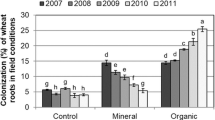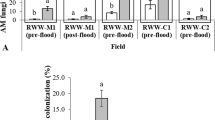Abstract
It has been difficult to explain the rotation effect based solely on N availability in maize-soybean cropping systems in the moist savanna zone of sub-Saharan Africa. Although arbuscular mycorrhizal fungi (AMF) can contribute to plant growth by reducing stresses resulting from other nutrient deficiencies (mainly P) and drought, their role in the maize/soybean rotation cropping systems in the Guinea savanna has not yet been determined. Pot and field experiments were conducted for 2 years using 13 farmers' fields with different cropping histories in two agroecological zones (Zaria, northern Guinea savanna and Zonkwa, southern Guinea savanna) in Nigeria. We quantified the influence of cropping systems and rhizobial inoculation on plant growth, mycorrhizal colonization and diversity of promiscuous soybean and maize grown in rotation. The relationships between these variables and selected soil characteristics in farmers' fields were also examined. Percentage mycorrhizal colonization in promiscuous soybean roots ranged from 7% to 36%, while in maize it varied between 17% and 33%, depending on fields and the previous cropping history. A large variation was also observed for mycorrhizal spores, but these were not correlated with mycorrhizal colonization and did not appear to be influenced by rotation systems. Soybean mycorrhizal colonization was higher (13% increase) in Zonkwa, but not in Zaria, if the preceding crop was maize and not soybean. These differences were related to the soil P concentration, which was positively related to mycorrhizal colonization in Zonkwa but negatively to this parameter in Zaria. The previous crop did not affect mycorrhizal colonization of maize in both locations. Soybean cultivars inoculated with rhizobia had a higher mycorrhizal colonization rate (25%) and more AMF species than maize or uninoculated soybean (19%). Maize grown in plots previously under inoculated soybean also had higher percentage mycorrhizal colonization than when grown after uninoculated soybean and maize. Four AMF genera comprising 29 species were observed at Zaria and Zonkwa. Glomus was the dominant genus (56%) followed by Gigaspora (26%) and Acaulospora (14%). The genus Sclerocystis was the least represented (4%).
Similar content being viewed by others
Author information
Authors and Affiliations
Additional information
Received: 28 October 1998
Rights and permissions
About this article
Cite this article
Sanginga, N., Carsky, R. & Dashiell, K. Arbuscular mycorrhizal fungi respond to rhizobial inoculation and cropping systems in farmers' fields in the Guinea savanna. Biol Fertil Soils 30, 179–186 (1999). https://doi.org/10.1007/s003740050606
Issue Date:
DOI: https://doi.org/10.1007/s003740050606




